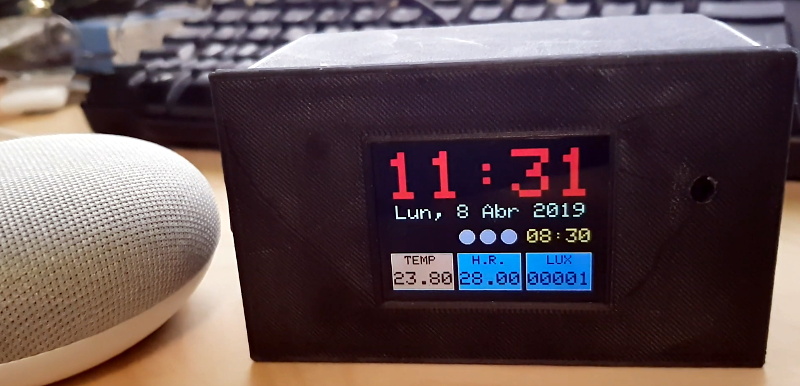The ESP family of microcontrollers is absolutely on fire right now, with a decent chunk of the projects that come our way now based on one of the impossibly cheap WiFi-enabled boards. In fact, they are so cheap and popular that we’ve started to see a somewhat unexpected trend; people have a tendency to use them as drop-in replacements, despite the more modern boards being considerably more powerful than required. The end result is a bunch of projects in which the ESP is simply underutilized. It’s not a big deal, but somewhat disappointing to see.
 But we can assure you this ESP32 alarm clock created by [Pangodream] is absolutely not one of them. He’s packed an impressive number of features into this unassuming little timepiece, and it’s really an excellent example of how much these boards are capable of without breaking a sweat. From DIY touch sensors to the Android application used to configure the clock over the network, this project is overflowing with neat hardware and software tricks worth taking a closer look at.
But we can assure you this ESP32 alarm clock created by [Pangodream] is absolutely not one of them. He’s packed an impressive number of features into this unassuming little timepiece, and it’s really an excellent example of how much these boards are capable of without breaking a sweat. From DIY touch sensors to the Android application used to configure the clock over the network, this project is overflowing with neat hardware and software tricks worth taking a closer look at.
Inside the 3D printed case, the clock features a BH150 light sensor, the very popular DHT-11 for detecting temperature and humidity, as well as a ILI9341 2.8 inch LCD for the display. In a particularly clever touch (get it?), [Pangodream] used three coins connected to the digital pins of the ESP32 as capacitive sensors. These allow him to interact with the click just by tapping the top of the case, and saved him the trouble of adding traditional switches or buttons. We might have put some indentations in the top case to make identifying which of the three “buttons” you’re pushing, but we suppose the invisible interface does make things look a little more futuristic.
But if even that is too much physical touching for you, then [Pangodream] has come up with a fairly robust system for controlling and interacting with the clock over the network. It’s not just a convenient way of setting the time, a good number of the clock’s functions can be polled and configured in this manner; everything from the sensitivity of the touch sensors to how many times it will beep when the alarm goes off. To make things easier, he’s even wrapped it all up in a handy Android application for on the go configuration.
If this clock doesn’t offer you the level of over-engineering you require, check out this build that uses no less than five ESP32s to get the job done. Or maybe this one that hooks into NASA’s Deep Space Network.
















>> “despite the more modern boards being considerably more powerful than required”
I think you could say that about a great deal of the projects these days ranging from Arduino’s and ESP’s to Raspberry Pi’s and pretty much everything in between.
I think the point is that the ESP (even the low end one) is something like an order of magnitude more powerful than the garden variety Arduino. You can come up with a project that pushes past what the Arduino can do just from feature creep.
So yeah you can drop in an ESP as an easy fix, but that’s challenging for an Arduino is usually not even scratching surface of what the ESP can do. Even if you ignore WiFi entirely.
Nice clock, btw.
“The ESP family of microcontrollers is absolutely on fire right now, with a decent chunk of the projects that come our way now based on one of the impossibly cheap WiFi-enabled boards”
ESP8266 , not ESP32. The ESP32 costs about $7.00 where an ESP8266 (01) is $1.50 shipped. Yes, ESP32’s have an “LCD mode”, but the TV and Composite -out hacks on the ESP8266 are far more impressive. The ESP32 is a tough sell when for nearly the same price, you can get a Lichee Pi or Raspberry pi Zero that runs a full Linux. Or get 5 ESP8266’s and use them together in a cluster.
that’s the truth. I’ve got an esp32 I picked up on the cheap off ebay ($4) but I’ve yet to come up with anything that needs it.
You can even add features like a radar based sleep monitor, text to speech news, weather and appointment reader, internet radio etc etc and still the powerful ESP32 will not have any problem with it all. See github for a code example: https://github.com/majodi/ESP32-Smart-Alarm-Clock
Or youtube for the result: https://youtu.be/J7KHj_QfIIQ
Just in case you are interested in how to build it or know a bit more of the project you can go to https://www.pangodream.es
That’s one weird store you must be looking at if it sells ESP8266 for 1.50$ but the ESP32 costs 7$, on AliExpress it’s like 3$ for the bare ESP32 module and 4$ for an entire NodeMCU-like board.
The above comment was meant as a reply to alxy.
And for some reason I’m incapable of doing it correctly.
we’re all waiting for hackaday to hackanew comment system. someday…